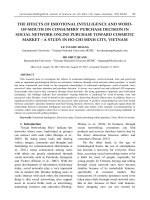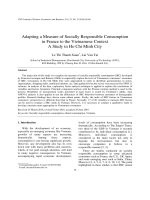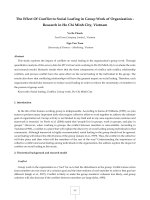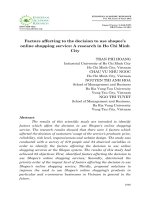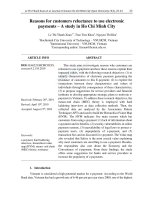Factors affecting to the decision to use shopee’s online shopping service: A research in Ho Chi Minh City
Bạn đang xem bản rút gọn của tài liệu. Xem và tải ngay bản đầy đủ của tài liệu tại đây (534.91 KB, 15 trang )
<span class='text_page_counter'>(1)</span><div class='page_container' data-page=1>
<b>Factors affecting to the decision to use shopee’s </b>
<b>online shopping service: A research in Ho Chi Minh </b>
<b>City </b>
TRAN PHI HOANG
Industrial University of Ho Chi Minh City
Ho Chi Minh City, Vietnam
CHAU VU NHU NGOC
Ho Chi Minh City, Vietnam
NGUYEN THI ANH HOA
School of Management and Business
Ba Ria Vung Tau University
Vung Tau City, Vietnam
NGO THI TUYET
School of Management and Business,
Ba Ria Vung University
Vung Tau City, Vietnam
<b>Abstract </b>
</div>
<span class='text_page_counter'>(2)</span><div class='page_container' data-page=2>
<b>Key words: customers’ service, customers’ behavior, decision to buy, </b>
<b>satisfaction, e-commerce </b>
<b>INTRODUCTION </b>
E-commerce (e-commerce) is known as an effective way of doing
business since the internet was created and developed. Vietnam
E-commerce market is getting more and more active. Google's research
and Temasek investment fund had announced in November that
Vietnam's e-commerce industry from now to 2025 would reach a 43%
growth rate, the highest among Southeast Asian countries (Dang
Truong , Doanh Nhan Sai Gon Online, 2019). According to Sapo’s
survey of over 5,000 online stores, more than 73% of online stores
admitted that doing business on electronic trading platforms such as
Lazada, Shopee, Adayroi... was really effective. According to the latest
data of Iprice Insight (2019), Shopee was becoming the largest
e-commerce platforms in Vietnam with more than 41 million visits /
month, far exceeding Tiki’s nearly 36 million visits / month. This
e-commerce platform started in 2018 at the 3rd position in website
traffic but within 7 months, Shopee had taken the leading position in
attracting visitors to visit and buy goods.
In recent years, many e-commerce enterprises in Vietnam
have been established alongside the brands which have succeeded and
made a name for themselves in the market such as Lazada, Shopee
etc. making competition between online retailers more and more
intense (Yang et al., 2003). What makes Shopee successful is one of
the things that online business enterprises, especially young start-up
businesses in Vietnam, need to study.
<b>THEORETICAL BASIS & RESEARCH HYPOTHESES </b>
</div>
<span class='text_page_counter'>(3)</span><div class='page_container' data-page=3>
Wilson et al. (2008) had reinforced the argument of Zeithaml and
Bitner (2000) when proving that service quality was the core factor in
directing customers to satisfaction, and the factor of price (service fee)
was also one of the factors which have an important impact on
customer satisfaction. In fact, many online buyers often pondered on
the price. (Yang et al, 2004).
Taylor and Croin (1995) in the Servperl model concluded that
there were 05 main factors affecting customer satisfaction when using
service’s products including: reliability, responsiveness, access, service
capabilities and tangible evidence. These factors would help
businesses to retain customers. Taylor and Croin had inherited the
theory of Servqual service quality from Parasuraman et al (1985). The
five elements in the Servperl model of Taylor and Croin (1995) had
also changed some factors in the ten factors in the Servqual model of
Parasuraman et al (1985), depending on the research object.
According to Dwyer et al (2000), the quality of services in the
online retail sector needed to focus on the "responsiveness" for
customers such as creating a good online shopping environment,
providing many options , screening information, creating product
comparisons, increasing reliability for customer etc. to enable
consumers to reduce effort when make a decision on purchasing.
Website was an online store so website design is very
important because it affects the quality of online services (Loiacono et
al., 2000). Wolfinbarger & Gilly (2001) commented that the
information available on the website was one of the important
features for businesses to easily sell goods online. Customers who
bought goods online would be aware of the benefits of receiving
information directly from the website without needing to consult
sellers (Zeithaml et al., 2002). Therefore, customers would be able to
reduce the cost of finding information, especially information related
to the product. If an online shopping site was informative and
well-organized, it was easy to attract customers to buy goods (Wolfinbarger
& Gilly, 2001). This also meant reducing the customers’s fear of risk
involved when buying goods online (Mangion et al, 2005; Hassan,
2000).
</div>
<span class='text_page_counter'>(4)</span><div class='page_container' data-page=4>
affecting consumer trends of customers. Positive customer’s attitudes
about the attributes of the service’s products will affect their
decisions. In addition, these authors also noted the impact from
people related to consumers (such as family, friends, colleagues,
relatives, social networking community) subjective (standard
subjective) also had a great impact, even creating consumer trends.
According to experts, online shopping businesses needed to connect
their online sales space (website design) to websites, where many
customers were interacting, to attract customers.
Based on the theories, doctrines, relevant research results and
assay’s results experts' opinions during the research process, it was
possible to conclude the factors affecting the decision to use online
shopping service at Shopee system (variable Y) include: price,
reliability, risk level, responsiveness and website design (variable X).
These factors were scales in the formal research model.
<b>The relationship between pricing and the decision to use the </b>
<b>service </b>
Price is the exchange value of the goods expressed in money; is the
amount of money to pay for a certain goods, service, or property; is the
quantity that changes around values. Price represents the supply and
demand relationship of one or a kind of goods. The price is expected to
reflect and match the value of the product with the quality of the
product (Arnould, 2003).
<i><b>Hypothesis H1: price affects the decision to use Shopee's online </b></i>
shopping service
<b>The relationship between the trust and the decision to use the </b>
<b>service </b>
Reliability is represented by characteristics such as quality products,
the ability to perform services on time right away, the ability to
ensure services are delivered as promised correctly (Cronin and
Taylor, 1995).
<i><b>Hypothesis H2: Customer confidence affects the decision to use </b></i>
</div>
<span class='text_page_counter'>(5)</span><div class='page_container' data-page=5>
<b>The relationship between the level of risk and the decision to </b>
<b>use the service </b>
The level of risk is the amount of unfortunate circumstances,
unpredictable possibilities, when and where they happen, as well as
theirs severity and consequences (Chann, 2001). The higher the level
of risk of an enterprise has, the lower the fewer customers decide to
use the service of that business, and vice versa.
<i><b>Hypothesis H3: Customer's risk level affects the decision to use </b></i>
Shopee's online shopping service.
<b>The relationship between the responsiveness and the decision </b>
<b>to use the service </b>
Responsiveness is the readiness to provide services to customers, the
assurance of quality, quantity of goods, delivery time, warranty mode,
etc. Responsiveness also manifests itself through workflows and the
steps taken to check the process which show the service provider’s
professionalism (Cronin and Taylor, 1995).
<i><b>Hypothesis H4: Shopee's responsiveness and sales intermediaries </b></i>
influence the decision to use Shopee's online shopping service.
<b>The relationship between website design and the decision to </b>
<b>use the service </b>
Website is a collection of sub-web, including text, images, video, flash
etc. The website is only in a domain or a subdomain hosted on servers
running online on the World Wide line of the Internet (British
Academy, 1990). The impact of websites on promotional activities is
huge because website design is able to create a series of activities
integrated with many online search engines, helping to increase the
amount of communication methods and techniques in order to interact
two-way with network users for the purpose of introducing products,
convincing viewers, attracting consumers’s attention and purchasing
decisions (Keller, 2000)
<i><b>Hypothesis H5: Shopee's website design affects the decision to use </b></i>
</div>
<span class='text_page_counter'>(6)</span><div class='page_container' data-page=6>
<b>RESEARCH METHODS </b>
This study was carried out through three steps: First, the authors
group conducted a qualitative research method to initiate group
discussions, consult with experts to select variables and observed
variables group. Next, based on the group of factors affecting the
decision to use online shopping service at Shopee system, the authors
group started to design a questionnaire to get opinions from 219
Shopee's online shopping service users.. Research model included: 05
scales, 26 observed variables. Used a 5-point Likert scale. Survey
results were imported and run on SPSS version 20.0. After verifying
the reliability with Cronbach's Alpha coefficient, the authors analyzed
the exploratory factor to minimize and summarize the data of the
scale (Dinh Phi Ho, 2010). This method is based on the Variance
Extracted Ratio(Eigenvalue), whereby only factors with a Variance
Extracted Ratio (Eigenvalue) greater than 1 would be retained, and
less than 1 wouldn’t have summarized information better than an
original variable, because after standardizing each original variable
had a variance of 1. The method of extracting principal components
and the Varimax Procedure used to minimize the number of variables
with a large coefficient in the same factor, increasing the ability to
explain factors. Used the above results to analyze multiples linear
regression to test the model’s assumptions, thereby considering the
impact of these factors on the decision to use online shopping services
in the Shopee system.
<b>RESEARCH RESULTS AND DISCUSSION </b>
<b>Table 1: Descriptive statistics </b>
<b>Code </b> <b>Observed variables </b> <b>N </b> <b>Mean </b>
G1 Price on Shopee is competitive 219 3.25
G2 Customers have the opportunity to compare prices 219 3.52
G3 Listed prices are clear and transparent 219 3.45
G4 Shopee has a reasonable price 219 3.63
G5 I like to buy goods with virtual coins 219 3.40
DTC1 The information is provided accurately 219 3.70
DTC2 Customers receive goods as shown on the system 219 3.54
DTC3 Is a prestigious brand 219 3.61
</div>
<span class='text_page_counter'>(7)</span><div class='page_container' data-page=7>
influence
DTC5 Associated with prestigious businesses 219 3.64
MDRR1 Personal information is absolutely secured 219 3.64
MDRR2 Confirm information as soon as ordering 219 3.69
MDRR3 There is a clear return policy 219 3.74
MDRR4 Feel safe when making transactions 219 3.59
MDRR5 Always solve problem for customers quickly and
promptly 219
3.48
KNDU1 Always provide a rich and diverse source of goods 219 3.48
KNDU2 Always respond to customers 24/24 219 3.55
KNDU3 Allow customers to choose from a variety of
transporters 219
3.56
KNDU4 Faster delivery than other units 219 3.52
KNDU5 Allow customers to choose from a variety of forms
of payment 219
3.59
TKTM1 Could easily perform all purchases and payments 219 3.58
TKTM2 Recommend products that you may need 219 3.51
TKTM3 Could easily find the products you need at Shopee 219 3.56
TKTM4 Online display of goods is beautiful and
professional 219
3.63
SHL1 I am very satisfied with the quality of Shopee's
service 219
3.53
SHL2 I will continue to use the Shopee homepage 219 3.54
SHL3 I will recommend Shopee to those in need 219 3.61
</div>
<span class='text_page_counter'>(8)</span><div class='page_container' data-page=8>
<b>Table 2: Scale measurement reliability test’s result (Cronbach’s </b>
<b>Alpha) </b>
<b>Variable </b> <b>Code </b> <b>Factors </b> <b>Cronbach’s Alpha </b>
<b>Independent </b>
<b>variable </b>
PR Price/Fee 0.801
RE Reliability 0.845
RL Risk level 0.777
RS Responsiveness 0.853
WD Website design 0.837
<b>Dependent </b>
<b>variable </b> GS Satisfaction 0.816
The results of table 2 showed that the scale had quite high accuracy
with Cronbach's Alpha coefficient> 0.7 and the corrected item-total
correlation of variables measuring this factor met the standard (>
0.3), only the variable "KNDU5_ Allowing customers to choose
multiple forms of payment" belonged to the scale of " Responsiveness"
with the correlation coefficient of 0.163 <0.3 should be eliminated.
After eliminating this variable, all scales were accepted.
<b>Table 3. Exploratory Factor Analysis </b>
<i><b>Component </b></i>
<i><b>Initial Eigenvalues </b></i>
<i><b>Total </b></i> <i><b>% of Variance </b></i> <i><b>Cumulative % </b></i>
1 8.425 36.629 36.629
2 1.988 8.641 45.270
3 1.527 6.641 51.911
4 1.377 5.988 57.899
5 1.191 5.177 63.076
The result of Exploratory Factor Analysis (EFA) in Table 3 showed
that the total variance extracted was 63.076%, greater than 50%, this
meant that the extracted factors could explain 63.706% of the model.
The remaining 36,924% would be explained by other factors. The
extracted factor (Eigenvalue) greater than 1 should be retained.
<i><b>Table 4 - Exploratory factor analysis </b></i>
<b>Code </b> <b>Component </b>
<b>1 </b> <b>2 </b> <b>3 </b> <b>4 </b> <b>5 </b>
G1 .790
G2 .747
G3 .734
G4 .693
G5 .653
</div>
<span class='text_page_counter'>(9)</span><div class='page_container' data-page=9>
DTC2 .752
DTC3 .701
DTC4 .672
DTC5 .754
MDRR1 .733
MDRR2 .727
MDRR3 .723
MDRR4 .830
MDRR5 .756
KNDU1 .637
KNDU2 .561
KNDU3 .554
KNDU4 .745
TKTM1 .647
TKTM2 .637
TKTM3 .622
TKTM4 .790
Through the Exploratory Factor Analysis (EFA), after reruning the
factor analysis, the model had completely been consistent with the
data, were calculated into 5 groups of factors and this result could be
used for multiple regression analysis.
<b>Table 5: Summary model </b>
Model R R Square Adjusted R
Square
Std. Error
of the
Estimate
Change Statistics
Durbin-Watson
R Square
Change
F Change df1 df2 Sig. F
Change
1 .767a .588 .579 .543 .588 60.867 5 213 .000 1.933
Research results in Table 5 showed that the correlation coefficients
were adjusted: R2<sub> = 0,588 (test F, sig. <0.05); meant that 58.8% of the </sub>
variation of variable F was explained by five independent variables
(Fi). Durbin – Watson coefficient (d) = 1.933; observation number n =
219, parameter k = 5, significance level 0.01 (99%), in the Durbin -
Watson statistics table, dL (lower statistical values) = 1,623 and dU
(upper statistical values ) = 1,725. So we have: (dL = 1,623) <(d =
</div>
<span class='text_page_counter'>(10)</span><div class='page_container' data-page=10>
<b>Table 6: ANOVA </b>
ANOVAa
<i><b>Model </b></i> <i><b>Sum of Squares </b></i> <i><b>df </b></i> <i><b>Mean Square </b></i> <i><b>F </b></i> <i><b>Sig. </b></i>
1
Regression 89.626 5 17.925 60.867 .000b
Residual 62.728 213 .294
Total 152.354 218
The test results had the value F = 60,867 and Sig. = 0,000 <0,05
showed that the construction model was suitable for the data set and
the variables included in the model were related to the dependent
variable. In general, regression analysis with reliability selected as
99%, corresponding to the selected variables with a statistical
significance of p <0.01; The result showed that all variables met the
demand. Testing the suitability of the model showed that there was
no violation of multicollinearity (VIF <10).
<b>Table 7. Factors affecting the decision of customers to use products </b>
<b>and services </b>
<b>Nhân tố </b>
<b>Beta </b> <b>chưa </b>
<b>chuẩn hóa </b>
<b>Beta chuẩn </b>
<b>hóa </b>
<b>t </b> <b>Sig. </b>
<b>95.0% Confidence </b>
<b>Interval for B </b>
<b>Collinearity </b>
<b>Statistics </b>
<b>B </b> <b>Std. </b>
<b>Error </b> <b>Beta </b>
<b>Lower </b>
<b>Bound </b>
<b>Upper </b>
<b>Bound </b> <b>T </b> <b>VIF </b>
1
(Constant) .090 .168 .538 .591 -.241 .422
F1 .198 .038 <i><b>.253 </b></i> 5.217 .000 .123 .274 .730 1.370
F2 .204 .037 <i><b>.262 </b></i> 5.538 .000 .131 .277 .768 1.303
F3 .131 .039 <i><b>.165 </b></i> 3.333 .001 .053 .208 .702 1.424
F4 .111 .039 <i><b>.139 </b></i> 2.857 .005 .035 .188 .722 1.385
F5 .264 .038 <i><b>.336 </b></i> 6.971 .000 .189 .339 .739 1.354
</div>
<span class='text_page_counter'>(11)</span><div class='page_container' data-page=11>
Responsiveness " increased by 1 point, the satisfaction level increased
by 0.139 points.
This result also reflected the true status of online shopping
business in Vietnam: poor web design, many online shoppers had not
trusted the online shopping system and the responsiveness for
Vietnamese consumers was still low. This result also had many
similarities with recent research by many authors.
<b>Figure 1: The influence of website design on customers </b>
Source: Lam Phuong, PVonline.vn, 2018
Statistics in Figure 1 show that Vietnamese online buyers were
affected by the attractive appearance of advertising websites (93%).
Customers were often attracted by eye-catching, clear, modern and
stylish designs. In addition, online shoppers were still afraid of risks,
while many online shopping businesses had yet to create trust and
responsiveness for Vietnamese consumers.
<b>Table 8. Feedback of online shoppers on social networks </b>
</div>
<span class='text_page_counter'>(12)</span><div class='page_container' data-page=12>
According to community feedback on social networks, the biggest risk
that online shoppers in Vietnam often faced was the slow delivery,
accounting for 31.8% and delivery of damaged goods but did not
recover, accounted for 28.1%. Other factors also reduced customers'
confidence and reflected the poor supply ability of businesses such as:
Delivery but didn’t provide invoices (14.5%), wrong delivery (10.1%),
announced goods was out of stock even though it was still in stock on
the website at a higher price (5.9%), promotional items lacking in the
delivery parcel (4.1%), vouchers couldn’t be used despite still valid
(3.2%), the product had no labels marks (2.3%) etc. In the forecasts of
many experts, Vietnam e-commerce sales would reach 10 billion USD
in 2020. Of which, about 30% of the population would buy online. This
forecast might be too optimistic but showed great potential in this
area. From here, there opened up opportunities for businesses that
had been and would start their businesses in online shopping in
Vietnam.
<b>CONCLUSIONS AND ADMINISTRATIVE IMPLICATIONS </b>
The results of this study show that all factors affect the decision to
use shopping services on Shopee. Thus, it is concluded that there is a
close relationship between groups of factors belong these variables:
risk level, website design, reliability, price, responsiveness and the
decision to use shopping services on Shopee. Research results are the
basis for proposing Shopee in particular and enterprises which do
connecting service businesses like Shopee to come up with their
strategies in the coming time. Based on the above research results, an
administrative implication is proposed to Shopee as follows.
</div>
<span class='text_page_counter'>(13)</span><div class='page_container' data-page=13>
with devices and communication channels in the internet, digital, and
social networks age: smartphones, laptops, Ipad, Facebook,
Instagram, Zalo, Youtube. com, Google ... Businesses want to meet the
need of customers need to sell on different channels to create a
seamless experience between sales channels.
Second, in order to limit "risk level" and to maximize the
"trust" for online shoppers, Shopee and businesses which connect
online shopping businesses such as Shopee need to strengthen their
guarantees of absolute safety for users of online purchase services
such as enhancing network security, confidentiality and the safety of
electronic payment information, strengthening product quality control
processes of distribution centers, taking measures to prevent, to
compensate contracts for distribution intermediaries, even initiating
lawsuits against enterprises selling counterfeit, fake and poor quality
goods. In addition, it is necessary for Shopee and other businesses to
propose amendments to the legal regulations that are no longer
suitable for e-commerce development in order for online shopping
business and electronic payments to become familiar to Vietnamese
people.
</div>
<span class='text_page_counter'>(14)</span><div class='page_container' data-page=14>
product that is being bought a lot, reduce the price strongly to give
customers the feeling that your store always sells cheaper than the
market; and freeshipping, selling related product package (or combo)
is also one of the tools to support price strategies in marketing./.
<b>REFERENCES </b>
1. Aladwani, A.M. & Palvia, P.C. (2002). Developing and
validating and instrument for measuring user-perceived Web
<i>quality, Information & Management, 39(6), 467-476. </i>
2. Alba, J., Lynch, J., Weitz, B., Janiszewski, C., Lutz, R.,
Sawyer, A. and Wood, S. (1997). Interactive home shopping:
consumer, retailer, and manufacturer incentives to participate
<i>in electronic marketplaces, Journal of Marketing, Vol.61, </i>
38-53.
3. Boyer, K.K., Hallowell,R. & Roth,A.V.(2002). E-service:
operating strategy—a case study and a method for analyzing
operational benefits, Journal of Operations Management
Vol.20, 175-188.
4. Brown, S.W., & Swartz, T.A. (1989). A gap analysis of
<i>professional service quality. Journal of Marketing, Vol. 53, </i>
92-98.
5. Buckley, J. (2003). E-service quality and the public sector,
<i>Managing Service Quality, 13(6), 453-462. </i>
6. Cai & Jun. (2003). Internet users’ perceptions of online service
quality: a comparison of online buyers and information
<i>searchers, Managing Service Quality, 13(6), 504-519. </i>
7. Casati, F., & Shan, M. (2001). Dynamic and adaptive
<i>composition of e-service, Information Systems, Vol.26, 143-163 </i>
<i>8. Chaffey, D., & Williams, E. M. (2002). Measuring online </i>
<i>service quality, Marketing online: Internet Marketing and </i>
e-Marketing Knowledge, available at:
www.marketing-online.co.uk/sqpap.htm
</div>
<span class='text_page_counter'>(15)</span><div class='page_container' data-page=15>
<i>brokers, Proceedings of 21st Annual International Conference </i>
on Information Systems, Brisbane, Australia.
10. Davis, F.D. (1993). User acceptance of information technology:
system characteristics, user perceptions and behavioral
<i>impacts, International Journal of Man-Machine Studies, </i>
38(3), 475-487.
11. Dabholkar, P.A., Thorpe, D.I. & Rentz, J.O. (1996). A measure
of service quality for retailing stores: scale development and
<i>validation, Journal of the Academy of Marketing Science, </i>
24(1), 3-16.
<i>12. Gefen, D. (2002). Customer loyalty in e-commerce, Journal of </i>
<i>the Association for information Systems, Vol.3, 27-51. </i>
13. Gefen, D. & Straub, D.W. (2004). Consumer trust in B2C
e-commerce and the importance of social presence: experiments
<i>in e-Products and e-Services, The International Journal of </i>
<i>Management Science, 407-424. </i>
<i>14. Goldsmith, R.E. (2001). Using the domain specific </i>
<i>innovativeness scale to identify innovation internet consumers, </i>
<i>Internet Research - Electronic Networking Applications and </i>
Policy, 11(2), 149-158
15. Janda, S., Trocchia, P.J. and Gwinner, K.P. (2002). Customer
<i>perceptions of internet retail service quality, International </i>
<i>Journal of Service Industry Management, 13(5), 412-431. </i>
16. Jarvenpaa, S.L. and Todd, P.A. (1997). Consumer reactions to
<i>electronic shopping on the World Wide Web, International </i>
<i>Journal of Electronic Commerce, 1(2), 59-88 </i>
17. Jun, M., Yang Z. And Kim D.S. (2004), ―Customers’
perceptions of online retailing service quality and their
<i>satisfaction‖, International Journal of Quality & Reliability </i>
<i>Management, 21 (8), 817-840. </i>
</div>
<!--links-->


